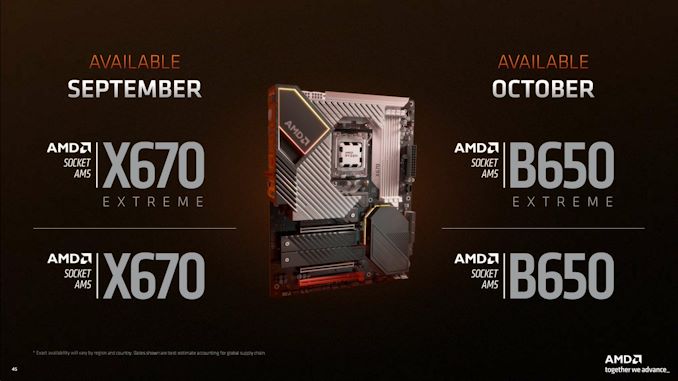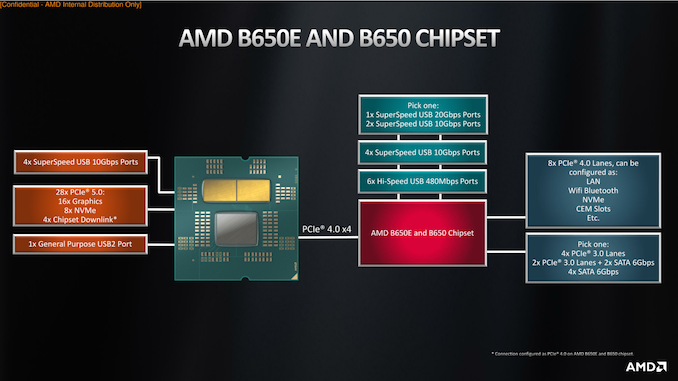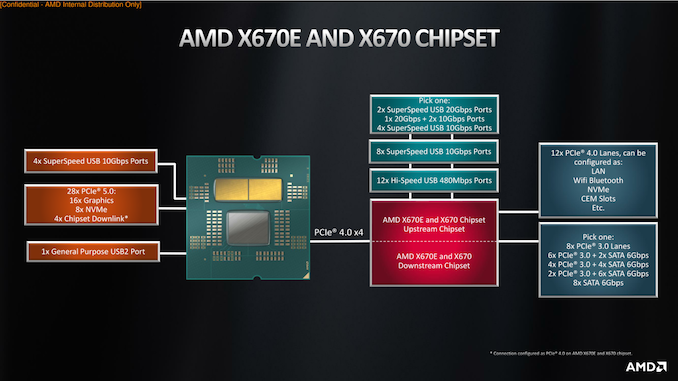AMD Zen 4 Ryzen 9 7950X and Ryzen 5 7600X Review: Retaking The High-End
by Ryan Smith & Gavin Bonshor on September 26, 2022 9:00 AM ESTAM5 Chipsets: X670 and B650, Built by ASMedia
Finally, let’s talk about the chipsets that are going to be driving the new AM5 platform. Kicking things off, we have the B650 and X670 chipsets, as well as their Extreme variations. Since AMD is starting the rollout of their new platform with their high-end CPUs, they are matching this with the rollout of their high-end chipsets.
For this week’s launch, the initial boards available are all from the X670 family. B650 boards will, in turn, be coming next month. We’ll break down the difference between the two families below, but at a high level, X670 offers more I/O options than B650. And while not strictly a feature of the chipset, the market segmentation is such that the bulk of high-end AM5 boards – those boards with a massive amount of VRMs and other overclocker/tweaker-friendly features – will be X670 boards.
That said, for simplicity’s sake we’re going to start with the B650 chipset, and build up from there.
| AMD AM5 Chipset Comparison | ||||
| Feature | X670E | X670 | B650E | B650 |
| CPU PCIe (PCIe) | 5.0 (Essentially Mandatory) | 4.0 (5.0 Optional) |
5.0 (Essentially Mandatory) | 4.0 (5.0 Optional) |
| CPU PCIe (M.2 Slots) | At Least 1 PCIe 5.0 Slot | |||
| Total CPU PCIe Lanes | 24 | |||
| Max Chipset PCIe Lanes | 12x 4.0 + 8x 3.0 | 8x 4.0 + 4x 3.0 | ||
| SuperSpeed 10Gbps USB Ports | 4 CPU + 12 Chipset or 4 CPU + 10 Chipset + 1 Chipset 20Gbps or 4 CPU + 8 Chipset + 2 Chipset 20Gbps |
4 CPU + 6 Chipset |
||
| DDR5 Support | Quad Channel (128-bit bus) Speeds TBD |
|||
| Wi-Fi 6E | Yes | |||
| CPU Overclocking Support | Y | Y | Y | Y |
| Memory Overclocking Support | Y | Y | Y | Y |
| Available | September 2022 | October 2022 | ||
B650, AMD’s mainstream AM5 chipset, can best be thought of as a PCIe 4.0 switch with a bunch of additional I/O baked in. And as is typical for chipsets these days, several of the I/O lanes coming from the chipset are flexible lanes that can be reallocated between various protocols. Meanwhile, uplink to the CPU is a PCIe 4.0 x4 connection.
For PCIe connectivity, B650 offers 8 PCIe 4.0 lanes, which can either have PCIe slots or further integrated peripherals (LAN, Wi-Fi, etc) hung off of them. This and the uplink speed are both notable improvements over the B550 chipset, which was PCIe 3.0 throughout, despite Ryzen 3000/5000 offering PCIe 4.0 connectivity. So B650 has a lot more bandwidth coming into it, and available to distribute to peripherals.
There are also a quartet of PCIe 3.0 lanes which are shared with the SATA ports, allowing for either 4 PCIe lanes, 2 lanes + 2 SATA, or 4 SATA ports. Notably, the dedicated SATA ports found on the 500 series chipsets are gone, so motherboards will always have to sacrifice PCIe lanes to enable SATA ports. For the B650 this amounts to a net loss of 2 SATA ports, as the most ports it can drive without a discrete storage controller is 4.
Meanwhile on the USB front, motherboard vendors get more Superspeed USB ports than before. The chipset offers a fixed 4 10Gbps Superspeed ports, and then an additional output can be configured as either a single 20Gbps (2x2) port, or two 10Gbps ports. Finally, the chipset can drive a further 6 USB 2 ports, mostly for on-board peripheral use. There are no USB root ports limited to 5Gbps here, so all USB 3.x ports, whether coming from the CPU or the chipset, are capable of 10Gbps operation.
AMD has once again outsourced chipset development for this generation to ASMedia, who also designed the B550 chipset. AMD has not disclosed a TDP for the chipset, but like B550 before it, it is designed to run with passive cooling.
Outside of the technical capabilities of the B650 chipset itself, AMD is also imposing some feature requirements on motherboard makers as part of the overall AM5 platform, and this is where the Extreme designation comes in. All B650 (and X670) motherboards must support at least 1 PCIe 5.0 x4 connection for storage; Raphael has enough lanes to drive two storage devices at those speeds, but it will be up to motherboard manufacturers if they want to actually run at those speeds (given the difficulty of PCIe 5.0 routing).
Extreme motherboards, in turn, will also require that PCIe 5.0 is supported to at least one PCIe slot – normally, the x16 PCIe Graphics (PEG) slot. Non-extreme motherboards will not require this, and while motherboard vendors could technically do it anyhow, it would defeat the purpose of (and higher margins afforded by) the Extreme branding. Conversely, while AMD has been careful to toe a line about calling 5.0 slots outright mandatory on Extreme motherboards, it’s clear that there’s some kind of licensing or validation program in place where motherboard makers would be driving up their costs for no good reason if they tried to make an Extreme board without 5.0 slots.
It’s frankly more confusing than it should be, owing to a lack of hard and definite rules set by AMD; but the messaging from AMD is that it shouldn’t be a real issue, and that if you see an Extreme motherboard, it will offer PCIe 5.0 to its graphics slot. Past that, offering 5.0 to additional slots, bifurcation support, etc is up to motherboard vendors. The more PCIe 5.0 slots they enable, the more expensive boards are going to be.
Meanwhile the high-end counterpart to the B650 chipset is the X670 chipset, which is pretty much just two B650 chipsets on a single board. While not explicitly confirmed by AMD, as we’ll see in the logical diagram for X670, there’s no way to escape the conclusion that X670 is just using B650 dies daisy chained off of one another to add more I/O lanes.
Officially, X670 is a two-chip solution, using what AMD terms the “downstream” and “upstream” chipsets. The upstream chip is connected to the CPU via a PCIe 4.0 x4 connection, and meanwhile the downstream chip is connected to the upstream chip via another PCIe 4.0 x4 connection.
By doubling up on the number of chips on board, the number of I/O lanes and options are virtually doubled. The sum total of the two chips offers up to 12 PCIe 4.0 lanes (the last 4 are consumed by the upstream chip feeding the downstream chip) and a further 8 PCIe 3.0 lanes that can be shifted between PCIe and up to 8 SATA ports.
Meanwhile on the USB front, there are now 8 fixed USB 2 ports and 8 fixed SuperSpeed USB 10Gbps ports. For USB flex I/O, motherboard makers can select from either 2 20Gbps ports, 1 20Gbps port plus 2 10Gbps ports, or 4 10Gbps ports.
And while this configuration adds more I/O lanes (and thus more I/O bandwidth), it should be noted that all of these I/O lanes are still gated behind the PCIe 4.0 x4 connection going back to the CPU. So the amount of backhaul bandwidth available between the chipsets and the CPU is not any higher than it is on B650. The name of the game here is flexibility; AMD is not designing this platform for lots of sustained, high-speed I/O outside of the CPU-connected x16 PCIe graphics slot and M.2 slots. Rather, it’s designed to have a lot of peripherals attached that are either low bandwidth, or only periodically need high bandwidths. If you need significantly more sustained I/O bandwidth, then in AMD’s ecosystem there is a very clear push towards Threadripper Pro products.
Finally, X670 Extreme (X670E) will impose the same PCIe 5.0 requirements as B650E. This means Extreme boards will offer PCIe 5.0 connectivity for at least one PCIe lane, while X670 boards are expected to come with just PCIe 4.0 slots. These will be the most expensive boards, owing to a combination of requiring two chipsets, as well as the extra costs and redrivers that go into extending PCIe 5.0 farther throughout a motherboard.
On that note, when discussing the new chipsets with AMD, the company did offer an explanation for why X670 daisy chains the chipsets. In short, daisy chaining allows for additional routing – the downstream chipset can be placed relative to the upstream chipset, instead of relative to the CPU (and PCIe devices then placed relative to the chipsets). In other words, this allows for spreading out I/O so that it’s not all so close to the CPU, making better use of the full (E)ATX board. As well, hanging both chipsets off of the CPU would consume another 4 PCIe lanes, which AMD would rather see going to additional storage.













205 Comments
View All Comments
Gigaplex - Wednesday, September 28, 2022 - link
Because there's a massive market for gamers that aren't gaming at 4K. Competitive e-sports comes to mind, where the CPU matters. Replyscrizz - Thursday, September 29, 2022 - link
FACTS ReplySilver5urfer - Saturday, October 1, 2022 - link
A CPU is not just "muh Gaming" only processor. Which is why we have a ton of benchmarks here apart from Games. Second part is 1080P resolution is still one to bench, esp when you talking about sub i5 and R6 CPUs they are going to be a 1080P machine not a 4K display.Second, Nvidia is a trash company do not even try to defend that - Ampere GPUs shoved with GDDR6X for Bandwidth nice but on purpose for mining, okay fine it's all Crypto and etc. But the PCB designs for RTX3090 is dumpster fire. They put Memory module near PCIe interface which will get a ton of mechanical stress AND the whole MSVDD power rail is complete pile of BS. It is prone to failure because of horrible VRM components and to make it worse Nvidia marked the 3090 price 2x of 3080 and had like 15% boost and then the VRAM on the back total fail. They fixed all of them with 3090Ti but at the end of cycle. Now they will "optimize" the drivers to gimp RTX3090Ti to make 40 series good, thats how this garbage company rolls. Imagine DLSS2 getting EOLed by FSR and then killed by DLSS3. That's pure trash garbage.
Now the new RTX40 series is coming with rip off 4070 silicon at trash 192Bit bus which means it's a 4K class pricing (RTX3090 is $950, 3090Ti is $1K) but doesn't have proper memory and 12GB, plus the DLSS3 is fake trash, giving BS frames to get idiots drool over the frame counter which is funny because the frames are NOT real.
HEDT is dead, nobody wants to buy them because nowadays people only play trash games like Apex, Fortnite, COD and etc GaaS trash titles and they buy PC for that only, and how many people do you think care about X670E PCH bandwidth being same as X570 nobody, you did not even mention. Market killed it, I also want HEDT but it won't come again, AMD destroyed their own HEDT with half cooked trash worse than X299. Intel SPR is delayed so HEDT is not coming back ever again it's all TR Pro, XEON W. Shame. Reply
Qasar - Sunday, October 2, 2022 - link
you come across as one angry person. wow ReplySilver5urfer - Sunday, October 2, 2022 - link
I bought a 3090FE and now planning to sell it off because of it's TRASH VRAM on the back and BS power delivery system, Nvidia themselves revealed on RTX4090FE using literally 1:1 PCB from RTX3090Ti and claiming much lower power excursions.Now It's my fault but the thing I bought the 3090FE year back while 3090Ti came this year, It's a mistake on my part but Nvidia has been doing this BS since a while now. GTX970 VRAM fiasco, 2070 cutting silicon a step down just like now RTX4070, and the RTX3000 series awful power delivery VRM. Now DLSS3 which is fake the game runs at same lower FPS but they add fake data to make the people think they are running at higher FPS and rendering the game. Scam on top of scam. Reply
vortmax2 - Sunday, October 16, 2022 - link
Maybe focus on the content of his post instead of the demeanor. ReplyQasar - Thursday, October 20, 2022 - link
" Maybe focus on the content of his post instead of the demeanor. "you obviously havent seen his previous posts. Reply
Cristian - Tuesday, September 27, 2022 - link
The section : "Ryzen 9 7950X at 65 W (ECO Mode): Zen 4 has Superb Efficiency" is exactly what I was looking for (and will build) .Thank you very much Anandtech ( Ryan Smith & Gavin Bonshor) ! ;) Reply
TheinsanegamerN - Tuesday, September 27, 2022 - link
A 7600x3d would be a superb gaming chip, if AMD makes one. Limit zen 4 to 65w and honestly these are pretty tasty. Curious how cool a 7600 runs on limited TDP. Replynandnandnand - Tuesday, September 27, 2022 - link
It would be interesting if they could put a bottom yield chip with less cache on the 7600X, and bump up the price by $30. Otherwise I don't think they'll bother.Limit the TDP yourself. Reply